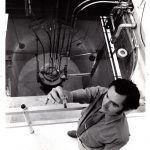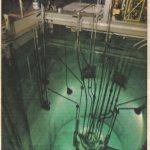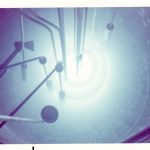The UCI Nuclear Reactor Facility is proud to offer our Activation Analysis Service (AAS), performing commercial neutron activation analysis for interested parties.
Overview
The process of neutron activation analysis (NAA) is used to identify and quantify many of the elements on the periodic table in various samples. Overall, the technique is extremely sensitive, accurate, and reproducible, making it the method of choice for many scientists and technicians in a wide array of fields, such as: chemistry, archaeology, biology, engineering, and earth system sciences. The general process is shown in the diagram below:

Samples are placed into the reactor, where they are exposed to neutrons. When neutrons collide with the nuclei of the sample, they may be absorbed and change the mass of the nucleus. This new configuration is often times unstable, also known as radioactive, and will emit energy and/or particles in order to achieve a stable configuration. The latter gamma-emission shown on the right side of the image is used in our detection process, which utilizes a gamma spectrometer made of high purity germanium. By measuring the energy of the gamma rays and the frequency at which they are detected, the elements can be identified and quantified using a few calculations.
Elements
Most of the naturally occurring elements on the periodic table can be analyzed in this manner, excluding a few of the lighter elements: H, He, Li, Be, B, C, N, and O. In alternate setups, such as prompt gamma NAA, most of these excluded lighter elements can be quantified. However, this facility is not currently equipped with a PGNAA setup.
Elements are listed below in their typical sensitivity and detection limits, but these are best case scenarios with minimal interference from the sample composition or matrix (adapted from Ragaini, R. ,Ralston, R. Garvis, D. UCRL 51855, June 1975, page 11).

Schedule
Irradiations are normally scheduled for every Tuesday. The amount of time required to process, measure, analyze, and report sample data depends on the elements requested and the sample composition. Elements activated to isotopes of shorter half-lives may be reported the same day as the irradiation, while elements with longer lived production isotopes typically take between one and three days. Examples of different time groups are given below:
Same Day: Al, Cl, Cu, Dy, In, V
Next Day: As, Cu, Na
Three Day: Au, Br, Cd, La, Pt, U, Th
Following Week or Longer: Ag, Ba, Cs, Cr, Co, Er, Gd, Hf, Ir, Ni, Rb, Sc, Sr, Te, Tm, Zn
Pricing
Our typical pricing is $110 per element per sample. However this may be adjusted depending on the complexity of the sample composition, incorporating handling and processing procedures. Please request a quote from Dr. George Miller at gemiller@uci.edu.
Additional Information
Samples as small as a few milligrams can be analyzed for most elements, even smaller for specific ones. Our standard sample size requested for liquid samples is 10mL, and 10g for solid, powder, or granular samples. Please do not send samples in pint, quart, or gallon quantities. Additional charges will be assessed for disposal costs associated with excessive quantities.
For any questions or inquiries, please contact John Keffer at jkeffer@uci.edu for more info.










